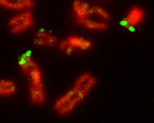Related Research Articles

A chromosome is a package of DNA with part or all of the genetic material of an organism. In most chromosomes, the very long thin DNA fibers are coated with nucleosome-forming packaging proteins; in eukaryotic cells the most important of these proteins are the histones. These proteins, aided by chaperone proteins, bind to and condense the DNA molecule to maintain its integrity. These chromosomes display a complex three-dimensional structure, which plays a significant role in transcriptional regulation.

In the fields of molecular biology and genetics, a genome is all the genetic information of an organism. It consists of nucleotide sequences of DNA. The nuclear genome includes protein-coding genes and non-coding genes, other functional regions of the genome such as regulatory sequences, and often a substantial fraction of junk DNA with no evident function. Almost all eukaryotes have mitochondria and a small mitochondrial genome. Algae and plants also contain chloroplasts with a chloroplast genome.
Genomic imprinting is an epigenetic phenomenon that causes genes to be expressed or not, depending on whether they are inherited from the female or male parent. Genes can also be partially imprinted. Partial imprinting occurs when alleles from both parents are differently expressed rather than complete expression and complete suppression of one parent's allele. Forms of genomic imprinting have been demonstrated in fungi, plants and animals. In 2014, there were about 150 imprinted genes known in mice and about half that in humans. As of 2019, 260 imprinted genes have been reported in mice and 228 in humans.

The human genome is a complete set of nucleic acid sequences for humans, encoded as the DNA within each of the 24 distinct chromosomes in the cell nucleus. A small DNA molecule is found within individual mitochondria. These are usually treated separately as the nuclear genome and the mitochondrial genome. Human genomes include both protein-coding DNA sequences and various types of DNA that does not encode proteins. The latter is a diverse category that includes DNA coding for non-translated RNA, such as that for ribosomal RNA, transfer RNA, ribozymes, small nuclear RNAs, and several types of regulatory RNAs. It also includes promoters and their associated gene-regulatory elements, DNA playing structural and replicatory roles, such as scaffolding regions, telomeres, centromeres, and origins of replication, plus large numbers of transposable elements, inserted viral DNA, non-functional pseudogenes and simple, highly repetitive sequences. Introns make up a large percentage of non-coding DNA. Some of this non-coding DNA is non-functional junk DNA, such as pseudogenes, but there is no firm consensus on the total amount of junk DNA.

The Y chromosome is one of two sex chromosomes in therian mammals and other organisms. Along with the X chromosome, it is part of the XY sex-determination system, in which the Y is the sex-determining chromosome because the presence of the Y chromosome causes offspring produced in sexual reproduction to be of male sex. In mammals, the Y chromosome contains the SRY gene, which triggers development of male gonads. The Y chromosome is passed only from male parents to male offspring.

Genome projects are scientific endeavours that ultimately aim to determine the complete genome sequence of an organism and to annotate protein-coding genes and other important genome-encoded features. The genome sequence of an organism includes the collective DNA sequences of each chromosome in the organism. For a bacterium containing a single chromosome, a genome project will aim to map the sequence of that chromosome. For the human species, whose genome includes 22 pairs of autosomes and 2 sex chromosomes, a complete genome sequence will involve 46 separate chromosome sequences.
Gene duplication is a major mechanism through which new genetic material is generated during molecular evolution. It can be defined as any duplication of a region of DNA that contains a gene. Gene duplications can arise as products of several types of errors in DNA replication and repair machinery as well as through fortuitous capture by selfish genetic elements. Common sources of gene duplications include ectopic recombination, retrotransposition event, aneuploidy, polyploidy, and replication slippage.

The pseudoautosomal regions, PAR1, PAR2, are homologous sequences of nucleotides on the X and Y chromosomes.

The ZW sex-determination system is a chromosomal system that determines the sex of offspring in birds, some fish and crustaceans such as the giant river prawn, some insects, the schistosome family of flatworms, and some reptiles, e.g. majority of snakes, lacertid lizards and monitors, including Komodo dragons. It is also present in some plants, where it has probably evolved independently on several occasions. The letters Z and W are used to distinguish this system from the XY sex-determination system. In the ZW system, females have a pair of dissimilar ZW chromosomes, and males have two similar ZZ chromosomes.

The Human Genome Project (HGP) was an international scientific research project with the goal of determining the base pairs that make up human DNA, and of identifying, mapping and sequencing all of the genes of the human genome from both a physical and a functional standpoint. It started in 1990 and was completed in 2003. It remains the world's largest collaborative biological project. Planning for the project started after it was adopted in 1984 by the US government, and it officially launched in 1990. It was declared complete on April 14, 2003, and included about 92% of the genome. Level "complete genome" was achieved in May 2021, with only 0.3% of the bases covered by potential issues. The final gapless assembly was finished in January 2022.
Wen-Hsiung Li is a Taiwanese-American scientist working in the fields of molecular evolution, population genetics, and genomics. He is currently the James Watson Professor of Ecology and Evolution at the University of Chicago and a Principal Investigator at the Institute of Information Science and Genomics Research Center, Academia Sinica, Taiwan.

Sex chromosomes are chromosomes that carry the genes that determine the sex of an individual. The human sex chromosomes are a typical pair of mammal allosomes. They differ from autosomes in form, size, and behavior. Whereas autosomes occur in homologous pairs whose members have the same form in a diploid cell, members of an allosome pair may differ from one another.

The western clawed frog is a species of frog in the family Pipidae, also known as tropical clawed frog. It is the only species in the genus Xenopus to have a diploid genome. Its genome has been sequenced, making it a significant model organism for genetics that complements the related species Xenopus laevis, a widely used vertebrate model for developmental biology. X. tropicalis also has a number of advantages over X. laevis in research, such as a much shorter generation time, smaller size, and a larger number of eggs per spawn.
Cancer genome sequencing is the whole genome sequencing of a single, homogeneous or heterogeneous group of cancer cells. It is a biochemical laboratory method for the characterization and identification of the DNA or RNA sequences of cancer cell(s).
Jennifer Ann Marshall Graves is an Australian geneticist. She is Distinguished Professor within the La Trobe Institute for Molecular Science, La Trobe University, Australia and Professor Emeritus of the Australian National University.

Aoife McLysaght is an Irish geneticist and a professor in the Molecular Evolution Laboratory of the Smurfit Institute of Genetics, Trinity College Dublin in Ireland.
Yaniv Erlich is an Israeli-American scientist. He formerly served as an Associate Professor of Computer Science at Columbia University and was the Chief Science Officer of MyHeritage. Erlich's work combines computer science and genomics.
Mutation bias is a pattern in which some type of mutation occurs more often than expected under uniformity. The types are most often defined by the molecular nature of the mutational change, but sometimes they are based on downstream effects, e.g., Ostrow, et al.

Kenro Kusumi is a genome biologist and professor, dean of The College of Liberal Arts and Sciences and senior vice provost at Arizona State University.
References
- ↑ "ASU researchers study the impact of sex chromosomes". The Arizona State Press. Retrieved 2019-06-13.
- 1 2 "Sex Chromosome Lab". Sex Chromosome Lab. Retrieved 2019-06-13.
- 1 2 "Melissa Wilson". Institute of Human Origins. 2019-06-12. Retrieved 2019-06-13.
- 1 2 3 4 "Why Y? Evolutionary biologist Dr Melissa Wilson Sayres joins RealScientists". RealScientists. 2014-04-06. Retrieved 2019-11-13.
- 1 2 "Profile – Helium Zone" . Retrieved 2019-11-13.
- 1 2 3 CV (PDF)
- ↑ Melissa A. Wilson Sayres (2010-12-16). "mathbionerd: My last name is two words, take two". mathbionerd. Retrieved 2019-11-13.
- ↑ Melissa A. Wilson (2019-03-02). "mathbionerd: Changing your name after divorce in academia". mathbionerd. Retrieved 2019-11-13.
- ↑ "Blurred lines: Human sex chromosome swapping occurs more often than previously thought". ScienceDaily. Retrieved 2019-06-13.
- ↑ "Study dispels theories of Y chromosome's demise". Berkeley News. 2001-11-30. Retrieved 2019-06-13.
- ↑ Ghose, Tia (12 November 2012). "Guys, Your Y Chromosome Is an Evolutionary Marvel". Live Science. Retrieved 2019-06-13.
- ↑ "Y Chromosome Likely To Stop Shrinking, Scientists Say (Phew!)". HuffPost UK. 2014-01-10. Retrieved 2019-11-13.
- ↑ Bowdler, Neil (2012-02-22). "Male extinction theory challenged" . Retrieved 2019-12-11.
- ↑ Starr, Michelle (31 May 2018). "Something Weird Happened to Men 7,000 Years Ago, And We Finally Know Why". ScienceAlert. Retrieved 2019-06-13.
- 1 2 Diep, Francie (14 June 2017). "8,000 Years Ago, 17 Women Reproduced for Every One Man". Pacific Standard . Retrieved 2019-06-13.
- ↑ Sarah Kaplan (March 18, 2015). "How Survival of the Fittest Became Survival of the Richest". The Washington Post .
- ↑ "Gila monster may help reveal evolution of sex chromosomes". Radio National. 2017-04-28. Retrieved 2019-06-13.
- 1 2 3 4 Yong, Ed (2016-10-18). "Arizona's Adorable Monster". The Atlantic . Retrieved 2019-06-13.
- ↑ "Gila monster genomics: conservation, venom, and treatments for Type-II diabetes". Experiment - Moving Science Forward. Retrieved 2019-12-11.
- ↑ Olney, Kimberly C.; Nyer, David B.; Sayres, Melissa A. Wilson; Haynes, Karmella A. (2018). "Activation of tumor suppressor genes in breast cancer cells by a synthetic chromatin effector". bioRxiv. 12 (1): 186056. doi: 10.1101/186056 . PMC 6156859 . PMID 30253781.
- ↑ Identifying, understanding, and correcting technical biases on the sex chromosomes in next-generation sequencing data: WilsonSayresLab/XYalign, Wilson Sayres Lab ARCHIVED Repositories, 2019-07-12, retrieved 2019-11-13
- ↑ TumorHeterogeneity, Wilson Sayres Lab ARCHIVED Repositories, 2019-04-30, retrieved 2019-11-13
- ↑ "Melissa Wilson". School of Life Sciences. Retrieved 2019-11-13.
- ↑ Angier, Natalie (2018-06-11). "Secrets of the Y Chromosome". The New York Times . ISSN 0362-4331 . Retrieved 2019-11-13.
- ↑ Wu, Katherine J. "The Earliest Mammals Kept Their Cool With Descended Testicles". Smithsonian . Retrieved 2019-11-13.
- ↑ Harmon, Amy (2018-10-19). "Geneticists Criticize Use of Science by White Nationalists to Justify 'Racial Purity'". The New York Times . ISSN 0362-4331 . Retrieved 2019-06-13.
- ↑ Keenan, Jillian (2014-06-04). "What National Review Doesn't Understand About Sex". Slate Magazine . Retrieved 2019-12-11.
- ↑ Ferreira, Becky (2018-12-05). "We Asked 105 Experts What Scares and Inspires Them Most About the Future". Vice . Retrieved 2019-11-13.